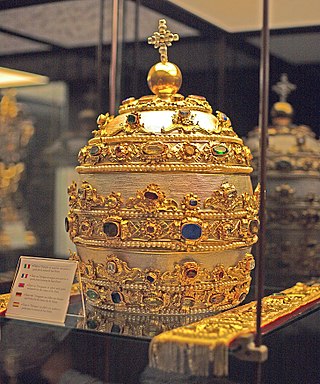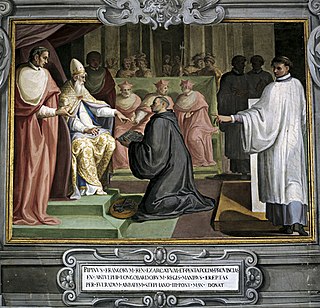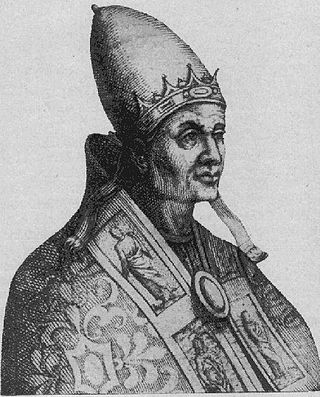See also
- List of popes by length of reign
- Western Schism, which from 1409 to 1414 saw three simultaneous claimants to the Papacy
- Year of the Three Kings
- Year of the Three Emperors
- Year of three prime ministers
A year of three popes is a year when the College of Cardinals of the Catholic Church is required to elect two new popes within the same calendar year. [1] Such a year generally occurs when a newly elected pope dies or resigns very early into his papacy. This results in the Catholic Church being led by three different popes during the same calendar year. In one instance, in 1276, there was a year of four popes.
The most recent instance of a year of three popes occurred in 1978. The three popes involved were: [2]
There have been thirteen instances in which exactly three popes have held office in a given calendar year. Years in which the Roman Catholic Church was led by three different popes include:
There was also a year in which the Roman Catholic Church was led by four popes, called the Year of Four Popes:

An antipope is a person who makes a significant and substantial attempt to occupy the position of Bishop of Rome and leader of the Catholic Church in opposition to the legitimately elected pope. At times between the 3rd and mid-15th centuries, antipopes were supported by important factions within the Church itself and by secular rulers.
Pope Benedict IX, born Theophylactus of Tusculum in Rome, was the bishop of Rome and ruler of the Papal States on three occasions between October 1032 and July 1048. Aged approximately 20 at his first election, he is one of the youngest popes in the world. He is the only person to have been Pope on more than one occasion and the only person ever to have sold the papacy.
Pope Gregory VI, born Giovanni Graziano in Rome, was bishop of Rome and ruler of the Papal States from 1 May 1045 until his resignation at the Council of Sutri on 20 December 1046.

The papal tiara is a crown that was worn by popes of the Catholic Church from as early as the 8th century to the mid-20th. It was last used by Pope Paul VI in 1963 and only at the beginning of his reign.
A jubilee is a special year of remission of sins and universal pardon. In Leviticus, a jubilee year is mentioned to occur every 50th year; during which slaves and prisoners would be freed, debts would be forgiven and the mercies of God would be particularly manifest.
Papabile is an unofficial Italian term first coined by Vaticanologists and now used internationally in many languages to describe a Catholic man, in practice always a cardinal, who is thought a likely or possible candidate to be elected pope. In some cases the cardinals will choose a papabile candidate. Among the papabili cardinals who have been elected pope are Eugenio Pacelli, Giovanni Battista Montini, and Joseph Ratzinger. However, at times the College of Cardinals elects a man who was not considered papabile by most Vatican watchers. In recent years those who were elected pope though not considered papabile include John XXIII, John Paul I, John Paul II. There is a saying among Vaticanologists: "He who enters the conclave as pope, leaves it as a cardinal." This is a popular proverb in Italy as well, indicating one should never be too sure of oneself.

Saeculum obscurum, also known as the Pornocracy or the Rule of the Harlots, was a period in the history of the Papacy during the first two-thirds of the 10th century, following the chaos after the death of Pope Formosus in 896 which saw seven or eight papal elections in as many years. It began with the installation of Pope Sergius III in 904 and lasted for sixty years until the death of Pope John XII in 964. During this period, the popes were influenced strongly by a powerful and allegedly corrupt aristocratic family, the Theophylacti, and their relatives and allies. The era is seen as one of the lowest points of the history of the Papal office.
A papal renunciation also called a papal abdication, occurs when the reigning pope of the Catholic Church voluntarily steps down from his position. As the reign of the pope has conventionally been from election until death, papal renunciation is an uncommon event. Before the 21st century, only five popes unambiguously resigned with historical certainty, all between the 10th and 15th centuries. Additionally, there are disputed claims of four popes having resigned, dating from the 3rd to the 11th centuries; a fifth disputed case may have involved an antipope.
Papal coats of arms are the personal coat of arms of popes of the Catholic Church. These have been a tradition since the Late Middle Ages, and has displayed his own, initially that of his family, and thus not unique to himself alone, but in some cases composed by him with symbols referring to his past or his aspirations. This personal coat of arms coexists with that of the Holy See.
The Papal Mint is the pope's institute for the production of hard cash. Papal Mint also refers to the buildings in Avignon, Rome, and elsewhere that used to house the mint..
The Secretariate of Briefs to Princes and of Latin Letters, or simply the Secretariate of Briefs, was one of the offices of the Roman Curia abrogated in 1967 during Pope Paul VI's reform of the Pontifical court. It was divided into two sections.

Papal appointment was a medieval method of selecting a pope. Popes have always been selected by a council of Church fathers, however, Papal selection before 1059 was often characterized by confirmation or nomination by secular European rulers or by their predecessors. The later procedures of the papal conclave are in large part designed to constrain the interference of secular rulers which characterized the first millennium of the Roman Catholic Church, and persisted in practices such as the creation of crown-cardinals and the jus exclusivae. Appointment might have taken several forms, with a variety of roles for the laity and civic leaders, Byzantine and Germanic emperors, and noble Roman families. The role of the election vis-a-vis the general population and the clergy was prone to vary considerably, with a nomination carrying weight that ranged from near total to a mere suggestion or ratification of a prior election.

From 756 to 857, the papacy shifted from the orbit of the Byzantine Empire to that of the kings of the Franks. Pepin the Short, Charlemagne, and Louis the Pious had considerable influence in the selection and administration of popes. The "Donation of Pepin" (756) ratified a new period of papal rule in central Italy, which became known as the Papal States.

The Tusculan Papacy was a period of papal history from 1012 to 1048 where three successive relatives of the counts of Tusculum were installed as pope.

Papal travel outside Rome has been historically rare, and voluntary travel of the pope was non-existent for the first 500 years. Pope John Paul II (1978–2005) undertook more pastoral trips than all his predecessors combined. Pope Francis (2013–present), Pope Paul VI (1963–1978) and Pope Benedict XVI (2005–2013) also travelled globally, the latter to a lesser extent due to his advanced age.

Articles related to Christianity include: